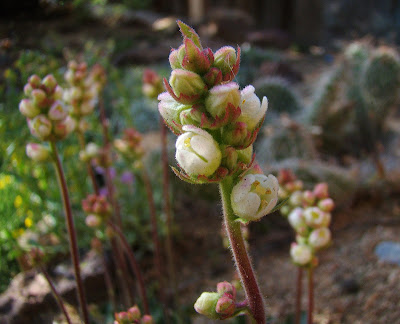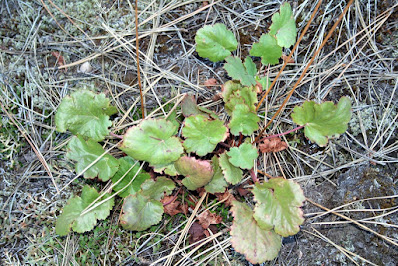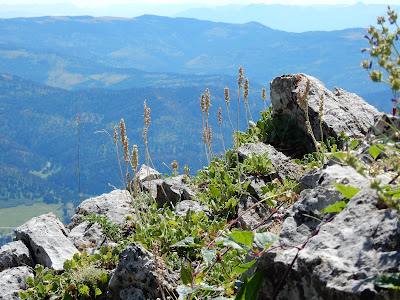Heuchera cylindrica do well in part sun, but stay away from hot afternoon rays - foliage will often fade, wilt, or scorch under intense sunlight...
Heuchera cylindrica also called as Roundleaf alumroot, Poker alumroot, is a species of the genus Heuchera. This species was described by David Douglas in 1832. The specific epithet means long and round, cylindrical. It is commonly called poker heuchera in reference to its poker-like spikes of creamy flowers. It is also commonly called roundleaf alumroot in reference to its rounded leaves.
IDENTIFY HEUCHERA CYCLINDRICA - ROUNDLEAF ALUMROOT - POKER ALUMROOT
Heuchera cylindrica is native to the western United States. The geographic range includes the Cascade Mountains of British Columbia and Washington, Idaho, western Montana, northwestern Wyoming, Oregon, and as far south as northern California. It is found in rocky areas in the woods, cliff-side ledges, slopes and sub-alpine meadows at low to mid elevations.
Roundleaf alumroot is hardy, clump forming perennial from short thick rhizomes and basal leaves. The dark green leaves are slightly hairy, round to oval shaped with toothed and scalloped margins. The entire plant is covered in short hairs
Poker alumroot blooms in the spring between April and May from the inflorescence which is a tall spike with the bell shaped flowers densely arranged terminally (the top of the flowering stem), the sepals that form the bell of the flower are white with pink margins. Fruit are small capsules.
HEUCHERA CYCLINDRICA - ROUNDLEAF ALUMROOT - POKER ALUMROOT CARE AND CULTURE
Cultural information should only be used as a guide, and should be to be adapted to suit you. Your physical location; where you grow your plants, how much time you have to devote to their care, and many other factors, will need to be taken into account. Only then can you decide on the cultural methods that best suit you and your plants.
Light:
Heuchera cylindrica do well in part sun, but stay away from hot afternoon rays - foliage will often fade, wilt, or scorch under intense sunlight. Instead, provide shade during the hottest times of the day, or plant where your plant will get consistent full or filtered shade.
Southern gardeners should plant in an area that receives morning sun and afternoon shade while Northern gardeners may plant in an area with more direct sun. Borders, perimeters, and walkways and patio containers are a great location.
Temperature:
Roundleaf alumroot can be grow in USDA Hardiness zone 4-9. A 50˚F to 55˚F nighttime air temperature and a 60˚F to 65˚F daytime air temperature are ideal. Root temperature is also very important for success with 55˚F to 60˚F being ideal. When nights stay above 40 °F, place your plants outside and leave them there. They can withstand winter temperatures to minus 25 °F when planted in the garden. In containers they can withstand about minus 5 °F.
Substrate and growing media:
Poker alumroot require well-drained soil. If you’ve had problems with these plants in the past, most likely you’ve tried to plant them in soil that’s too wet or full of clay. To solve that, plant in raised beds, on a berm, or in containers. Even mounding the soil slightly where you plant them will help. A premium organic planting compost will provide excellent drainage with enough moisture.
Ideal garden soil is easy to dig in and drains well while still holding the nutrients and water vital to plant growth. To prepare a bed for in-ground planting, spade or till the soil to a depth of roughly 12-18 inches. Next, spread a 2-4 inch layer of organic matter such as compost, shredded leaves or peat moss over the soil and mix well.
Keep the area around your plants free of weeds. Weeds compete with surrounding plants for food, water and light. Walk around the garden periodically and pull weeds, including the roots, as soon as you see them.
Watering:
You should not allow the soil or the original root ball to completely dry out. During the first summer, you may need to water as often as every few days in periods of drought and extreme summer heat. To determine if your plant needs water, dig a few inches into the soil next to the plant. If the soil is dry 2-3 inches below the surface, it is time to water.
Overwatering can be as damaging as under watering. Be sure that the area surrounding your plant has adequate drainage to move water away from the plant. If you choose to plant in a container, always select one with drainage holes to prevent your plant's roots from sitting in water.
Fertilizer:
Fertilize your plants once every 2-3 weeks during the growing season with a water-soluble fertilizer. Discontinue feeding after September 1st so your plants can harden off for winter dormancy. Resume fertilizing when new growth appears in spring.
Pruning and mulching:
Clip off any dead, damaged or unsightly growth as needed to maintain an attractive appearance. In late fall or early spring, cut each plant back to a few inches above the ground. New growth will emerge as spring temperatures rise.
When flowers fade, they can be spun off with a flick of the wrist. If stems get too long they can be cut off with the resulting stub re-sprouting and the piece in your hand replanted to form a new plant. This helps keep your plant compact.
Apply a 2-4 inch layer of shredded bark, compost, leaves, straw or other organic matter around your plants to promote moisture retention, maintain even soil temperatures and discourage weed growth. Replenish the mulch as needed.
Winter period:
Heuchera cylindrica is winter hardy, but will benefit from mulching in very cold areas. The time to winterize your plants is in late fall. When winterizing perennials, keep in mind that the root system is the most vulnerable to cold damage. Mulch heavily by mounding a 6-8 inch layer of shredded bark, compost, leaves, straw or other organic material over the crown of each plant.
Watering thoroughly in late fall will greatly enhance your plant's cold tolerance once the ground has frozen.
In very cold areas, containerized plants can be brought into an unheated, protected area such as a garage or cellar before temperatures drop below freezing. Check soil moisture every 2-3 weeks and water as needed during winter.
In spring, remove mulch from in-ground plantings. Containerized plants should be moved back out into the garden sunlight where they will begin to repeat their yearly garden performance.
Pests and diseases:
Roundleaf alumroot have relatively few pests but they do have one nemesis: strawberry or black vine weevil. If you have had plants whose tops “fall off” in the spring, they are being eaten underground by these little monsters. These are creamy-white c-shaped grubs. You must fight with a twofold attack; the brown or black adults are out in late May to early June (watch for munched leaves) and can be sprayed with Bonide Systemic Insect Control. DO spray at night as that’s when they come to play (and eat). In fall, beneficial nematodes like NemaGlobe can be sprayed over the soil around the plants. Remember to water before and after the application to get these critters in the soil. Each adult can lay 300 eggs, so control is highly advised. Organic gardeners who experience the tops of plants falling off (from weevil damage) can pour hot water on the ground to kill existing larvae.
There are two diseases you might see on the plant: mildew and rust. Mildew tends only to attack varieties of Heuchera sanguinea. Organic controls such as baking soda in water can provide some prevention. Mancozeb can be applied as both a preventative and a remedy. Rust can be a severe problem if the plants are moist and the temperature is in the 45º -50ºF range. Plants will appear dark-spotted from above and when a leaf is turned over, orange patches are evident. While rust won’t kill a plant, it is quite ugly and contagious. Preventative measures include clean, dry facilities (for growers) and copper-based sprays as used on fruit trees. Mancozeb, Cleary’s or Daconil can also prevent an attack and provide long-term control. Yellow-leaved heuchera seem most susceptible. Once a plant has been attacked, remove the affected leaves and apply one of the above sprays. Clean equipment with alcohol after use.
Propagation:
While most are initially propagated by tissue-culture, the plants can be divided by a sharp shovel in early spring when the soil has thawed. The plants should be divided once every 3-5 years. A two-year-old plant can easily be divided into 6 plants. In early spring or fall, begin by digging up a mature clump. Cut the plant with a shovel or other sharp tool, making sure each division has plenty of roots. Plant the divisions back in the garden and water well. Foliage may have to be removed if any wilting is observed.
The plants can also grow from seeds. The seeds must be sown on top of the medium to germinate. Thoroughly moisten sterile seed-starting mix and then fill your seed tray to the top. Soil can be gently tamped. Seed must be sowed sparingly. Otherwise the mat of dense seedlings will be nearly impossible to pull apart. Germination usually begins after 8 to 14 days in soil that is at a temperature of 70º-72ºF. Once the tiny plants have 3-4 true leaves, they can be transplanted to cell packs or a soil flat to grow on. When plants are 3” across, they can be transferred to pots or the garden and watered gently. If they are being moved into full sun, it must be done gradually over a week’s time or they will burn badly.
Leaf cuttings is another method for propagation. Take healthy mature leaves with a short segment of the petiole; dip in rooting powder, place in sterile media (mixture of peat moss and perlite), and use a clear polyethylene cover to keep the humidly high.

















COMMENTS